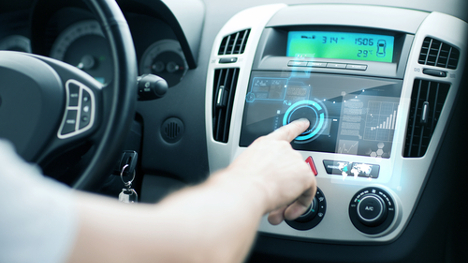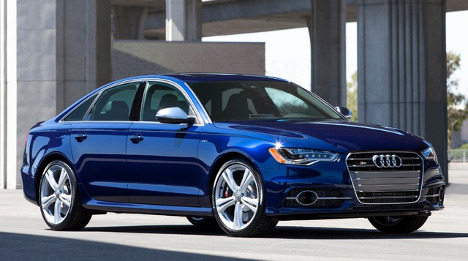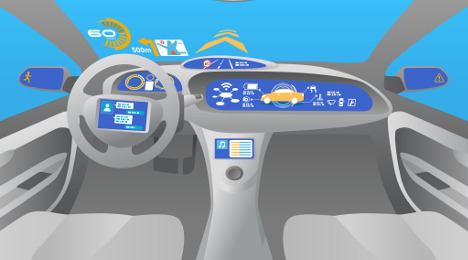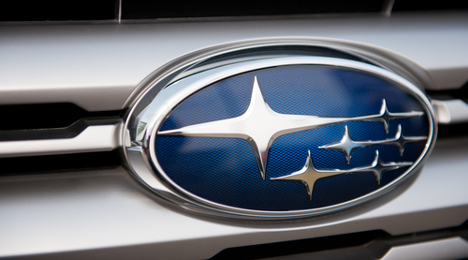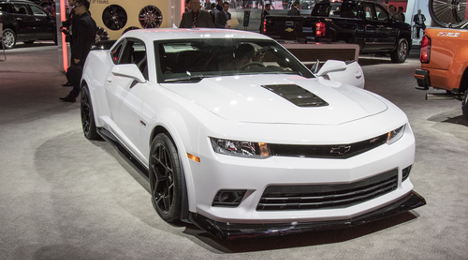Although vehicle technology is progressing at a rapid rate — even self-driving cars are no longer just an idea — it seems some of this very same tech evolution is continuing to cause vehicle owners problems.
According to the J.D. Power 2016 U.S. Vehicle Dependability Study released Wednesday, technology continues to affect vehicle reliability.
The study, which found Lexus ranked the highest in vehicle dependability for the fifth year in a row, also showed the number of problems with infotainment, navigation and in-vehicle communication systems (which together are known as audio, communication, entertainment and navigation or ACEN) has spiked.
These types of issues now account for 20 percent of all customer-reported problems in the study, making it the most problematic areas on most vehicles. This is also the cause of the 3-percent year-over-year decline in vehicle dependability, according to the study, which is based on responses from 33,560 original owners of 2013 model-year vehicles after three years of ownership.
And this is particularly interesting, because 2015 sure brought up a lot of issues when it comes to trust in vehicles. Just look at the VW emissions scandal, or the giant Takata airbag recall — that seems to just keep growing — for example.
But, it seems vehicle owners are most worried about the tech problems that continue to plague their cars and trucks. In fact, in mid-February, General Motors confirmed that it will recall approximately 200,000 Saab and Saturn vehicles that contain Takata PSDI-5 driver front airbag inflators. In other words, the recalls just keep coming.
“The increase in technology-related problems has two sources,” Renee Stephens, vice president of U.S. automotive at J.D. Power, noted in the company's analysis. “Usability problems that customers reported during their first 90 days of ownership are still bothering them three years later in ever-higher numbers. At the same time, the penetration of these features has increased year over year.”
What are the most reported problems with ACEN?
- Bluetooth pairing/connectivity and built-in voice recognition systems misinterpreting commands.
- Navigation system difficult to use, and navigation system inaccurate.
Once again, Lexus took the No. 1 spot for vehicle dependability among all brands, with a score of 95 problems per 100 vehicles.
According to the J.D. Power study, Porsche came in second when it comes to vehicle dependability with a score of 97, moving up from fifth in 2015.
Following Porsche in the rankings in the study were Buick (106), Toyota (113) and GMC (120).
General Motors also scored big with eight segment awards for the following vehicles: Buick Encore; Buick LaCrosse; Buick Verano; Chevrolet Camaro; Chevrolet Equinox; Chevrolet Malibu; Chevrolet Silverado HD; and GMC Yukon.
And Toyota took home six segment awards for its Lexus ES, Lexus GS, Lexus GX, Toyota Prius v, Toyota Sienna and Toyota Tundra.
Durability rankings
On the durability front, automotive research firm iSeeCars.com analyzed of a sample of 12 million cars on the road in 2015 from model years 1981 and newer to determine the models with the higher percentage of vehicles over 200,000 miles.
Interestingly enough, Lexus didn’t show up in the durability luxury rankings at all, despite topping the the dependability rankings.
The Lincoln Navigator took the top durability spot (from iSeeCars) with 2 percent of vehicles over 200,000 miles. Next up was the Cadillac Escalade with 1.4 percent, following by the Acura MDX at 1.3 percent.
On the mainstream side of things of the iSeeCars study on the longest lasting vehicles, the Ford F-250 topped the list with 6 percent of vehicles over 200,000 miles.
In line with J.D. Power’s findings on dependability, it seems GM and Toyota cars are lasting quite a while for their owners, as well. GM had six vehicles on iSeeCars longest lasting vehicles list, while Toyota had four.
How automakers build ‘trust in technology’
J.D. Power warned that while automakers are moving toward ground-breaking tech feats such as fully autonomous vehicles on the road, consumers still need to have confidence these technologies will work.
That said, autonomous features are appealing to car shoppers. In fact, a small percentage (8 percent) of the 175 automotive executives in 21 countries that IBM surveyed in its Automotive 2025: Industry without borders study think autonomous vehicles will be in mainstream use as soon as in the next 10 years. A much larger percentage (38 percent) think they will at least be in limited use in the mainstream market.
And after surveying a panel of over 1,000 vehicle owners online last year for its 2016 In-Vehicle Technology Shopper Influence Study, Autotrader found that 70 percent of the consumers surveyed are more likely to consider a vehicle with autonomous features, such as parking assistance, collision avoidance and automatic braking.
“If you think about the technology problems from the study in the context of conversations around autonomous vehicles, the industry clearly has more work to do to secure the trust of consumers,” said Stephens. “Right now, if consumers can’t rely on their vehicle to connect to their smartphone, or have faith that their navigation system will route them to their destination, they’re certainly not yet ready to trust that autonomous technology will keep their vehicle out of the ditch.”
Reliability is also critically important to vehicle dependability, including technology, and according to the study, more than 50 percent of owners cite reliability as one of the most influential reasons for choosing a specific make and model.
At the same time, concerns about reliability have risen this year as a reason to avoid particular models — due mostly to the large number of recalls launched over the course of the past couple of years.
“The decline in reliability coupled with a record number of vehicle recalls and safety-related complaints affect consumer confidence,” said Stephens. “Dependability has a direct impact on purchase decisions and brand loyalty.”
Bernie Sanders or Hillary Clinton? Donald Trump or Ted Cruz? These folks may be the current polling frontrunners in the state of Iowa, which was set to hold its caucuses Monday night, but the state’s frontrunners in the new automotive space are a bit clearer: They tend to buy American.
A recent analysis of 2015 new-car registration data by Edmunds.com shows that 63 percent of Iowa’s purchases last year were from domestic brands. That’s a hefty portion of the state, especially considering domestic new-vehicle purchases accounted for roughly 42 percent of those purchased throughout the entire United States last year.
This may also have a lot to do with the fact that 24 percent of those purchases made in the farming-heavy state last year were pickup trucks (compared to 15 percent nationally), a segment heavily dominated by domestic manufacturers. Add SUVs to the trucks, and you’ll see that those two segments combined accounted for 63 percent of all new-vehicle registrations in Iowa last year, compared to 52 percent nationally.
That blue-collar theme appears to repeat itself when looking at the luxury versus non-luxury spread in Iowa, where only 5 percent of the vehicles registered in the state last year fall into the luxury category, compared to the industry average of 13 percent nationwide.
The fact that flex-fuel vehicles, equipped with engines that can handle fuel with higher ratios of ethanol, make up 16 percent of Iowa’s new purchases last year is probably not a surprise to the state’s residents considering half of all of the state’s corn is used to produce ethanol. That’s a substantial increase over the national average of 11 percent.
And although Iowa may be considered a “blue” state in the political sense in recent years, with President Barack Obama winning the state in the last two elections, in a car-color sense, red beats out blue in Iowa, with 14.1 percent of the vehicles registered in the state last year being red (compared to 9.4 percent blue). Red was by no means the most-popular color, however (it was fourth); white, black and silver were the most-registered colors in the state, respectively.
Many customers that choose to buy certified pre-owned do so because they want a like-new experience without the price tag.
If this mindset rings true for some of your shoppers, you might want to take note of Autotrader’s latest list.
Autotrader analysts picked 10 luxury CPO vehicles and 10 non-luxury CPO vehicles that are “almost as good as new.”
The must-shop CPO cars offer a similar look to their brand-new counterparts while enabling shoppers to get used-car pricing and a manufacturer-backed warranty.
"New cars can be expensive, particularly if the desired features are only included in higher trim packages," said Brian Moody, executive editor at Autotrader. "In addition, used vehicles can sometimes fuel uncertainty about reliability. Cost-conscious shoppers will find that certified pre-owned vehicles are a great bridge between used and new cars — offering the peace of mind they want with a price tag they can afford."
The vehicles on the list, which include models such as the 2014-2015 Chevrolet Impala and the 2014-2015 Acura MDX, were chosen based on criteria encompassing price, safety rating and warranty details.
"We realized that the criteria for our luxury list was naturally going to differ slightly from that of our non-luxury list," said Tara Trompeter, managing editor at Autotrader. "Luxury and non-luxury consumers want and expect different things, and we took that into consideration when coming up with these benchmarks."
The criteria, outlined by Autotrader editors, is below:
Criteria used for CPO luxury vehicles: a retail price of approximately $50,000 or less; a manufacturer-backed certified warranty; similar look to a current new car; a minimum of 5 years or 100,000 miles of powertrain coverage included in the purchase price; and an overall federal government safety rating of 5 stars.
Criteria used for CPO non-luxury vehicles: a retail price of approximately $35,000 or less; a manufacturer-backed certified warranty; similar look to a current new car; a minimum of 5 years or 100,000 miles of powertrain coverage included in the purchase price; an overall federal government safety rating of at least 4 out of 5 stars; and a warranty deductible of $50 or less (based on results from a recent Autotrader poll that showed a CPO warranty deductible of $50 or less is favored by two‑thirds of the respondents).
Autotrader’s ‘Must-Shop’ CPO Vehicles
|
10 Must-Shop CPO Luxury Vehicles
|
10 Must-Shop CPO Non-Luxury Vehicles
|
|
2014-2015 Acura MDX
|
2014-2015 Chevrolet Impala
|
|
2012-2015 Audi 6
|
2012-2015 GMC Terrain
|
|
2012-2015 BMW 3 Series
|
2011-2014 Honda Odyssey
|
|
2012-2015 Buick Verano
|
2013-2015 Hyundai Santa Fe
|
|
2014-2015 GMC Sierra 1500 Denali
|
2014-2015 Kia Soul
|
|
2013-2015 Infiniti JX35/QX60
|
2014-2015 Mazda6
|
|
2014-2015 Lexus IS
|
2014-2015 MINI Cooper
|
|
2013-2015 Lincoln MKZ
|
2013-2014 Nissan Pathfinder
|
|
2012-2015 Volvo S60
|
2013-2015 Subaru BRZ
|
|
2012-2015 Volvo XC60
|
2011-2014 Toyota Tundra
|
|
(Top 10 models appear in alphabetical order.)
|
When you’re driving down the road, how many of the cars in motion around you are being physically driven by fellow humans? More often than not, all of them.
Thinking of an answer to this question, today, may seem quite silly. By the time our millennial readers are old and gray, however, it won’t be.
It’s well known that a variety of auto manufacturers and outside technology companies are preparing for the day that autonomous driving becomes mainstream.
In fact, a small percentage (8 percent) of the 175 automotive executives in 21 countries that IBM surveyed in its Automotive 2025: Industry without borders study think autonomous vehicles will be in mainstream use as soon as in the next 10 years. A much larger percentage (38 percent) think they will at least be in limited use in the mainstream market.
“But how does that affect my dealership today?” you may ask.
Well, there are plenty of autonomous features that are currently hitting the mainstream — and consumers want them. The technologies may not be driving the cars for us yet, but with lane-departure warnings, autonomous braking, and guided cruise control, it’s safe to say we’re perhaps not that far from it.
Autotrader recently presented the findings of its 2016 In-Vehicle Technology Shopper Influence Study at the 2016 International Consumer Electronics Show (CES) and a not-so-surprising percentage of consumers would like more autonomous features in their vehicles.
After surveying a panel of over 1,000 vehicle owners online last year, Autotrader found that 70 percent of the consumers surveyed are more likely to consider a vehicle with autonomous features, such as parking assistance, collision avoidance and automatic braking.
One interesting finding, fleshed out by Autotrader’s associate research manager Rachelle Petusky, is that these in-car technologies are changing what many consumers perceive to be a luxury vehicle.
“When we ask consumers about what defines a luxury vehicle, traditionally in the past consumers have broken it out by automakers that play in the luxury space, such as Audi or BMW,” Petusky said. “But technology’s really changing the game, and non-luxury vehicles are starting to be viewed as a luxury vehicle because of the technologies offered in the car. Things like Wi-Fi, lane change assistance, collision avoidance are helping consumers perceive non-luxury cars as luxuries.”
Since this is the second year that Autotrader has conducted this study, Auto Remarketing asked Petusky what the biggest change Autotrader has seen seen in consumer expectations over the last year.
Petusky pointed to the 77 percent that want a car with all of the technology features they want regardless of car color.
“Probably the biggest change that we saw was the fact that technology is becoming even more important than car color,” Petusky said. “Car color, I think, has been a part of a huge conversation. It still is very relevant in the purchase decision, but technology is definitely going to have more of an impact now than it did last year.”
While Autotrader finds that the majority (60 percent) of the consumers surveyed think self-driving vehicles are a dangerous idea, there are plenty that are more than willing to pay extra for the new technologies that are out today.
Forty four percent of those surveyed said they would pay up to $1,499, which Petusky says is a bit of a “magic number” in the technology package pricing game, for an in-vehicle concierge service. And 65 percent said they would switch brands to get the features they want.
On that note of branding, while Petusky says that in the immediate term it isn’t that cost effective to upgrade used vehicles with some of the new features that are coming out, the used cars that are most popular in the future will be heavily dependent on who adapts what technologies in their new vehicles now.
“But I think as automakers and technology companies figure out how to make it more cost-effective, it is going to start shifting consideration,” she said. “We’re already seeing some consumers that are shopping for new cars that are going to switch brands if the technology that they want isn’t in the car that they want.
“So I think even as people are looking at used cars, it may change which used car they’re considering depending upon which manufacturer is earlier to the game to introducing new technologies in their cars.”
These new technologies are also expected to not only change how automakers certify used vehicles in the future, but also impact the value that used cars retain.
“I think there’s definitely certain things that they’re going to have to check to make sure they’re functioning properly,” Petusky said. “Our sister company, Kelley Blue Book, is actually seeing that vehicle technology is impacting the valuation price of used inventory.
“I think that vehicles that are in good or excellent condition that have that additional technology in the car, it’s just going to be a way that they can ask for a higher price point and that inventory is going to move faster compared to certified inventory that doesn’t.”
Petusky also thinks that dealers and aftermarket companies that can add some of the more affordable new technologies, especially backup cameras, to older vehicles, can reap the benefits.
“That’ll really be a way to differentiate themselves from other dealers,” she said.
There is one feature that customers don’t necessarily care for their vehicle to have completely integrated: navigation. Fifty seven percent said they would rather manufacturers focus on better integration with their smartphones, while 39 percent said they would prefer the navigation system on a smartphone rather than one built into the vehicle.
“We definitely see it continuing to swing toward people wanting to just use the navigation system that’s in their phone,” Petusky said. “But they are wanting that to easily integrate into the dash. Some of the other apps and functions that people are doing on their smart phones now they are willing to surrender to the dash.”
With more than 235 model options in the new-vehicle marketplace, customers shopping in that arena are a bit spoiled for choice. Understanding what customers are drawn to, and, perhaps more importantly, turned off by, can be what sets a good car apart from a great car.
That’s where the annual J.D. Power Avoider Study comes in, and this year its analysis has shown an increased concern for vehicle reliability.
According to the study, which surveyed nearly 26,500 owners who registered a new vehicle in April and May of last year, 55 percent said that vehicle reliability was a leading reason for their purchase, up from 51 percent in the previous year’s study.
Looking at it from the opposite angle, 17 percent said perceived reliability was a chief reason why they avoided a certain vehicle, versus 14 percent the previous year.
"Though vehicle reliability and durability have improved significantly over the years, they remain a vital consideration for consumers," said Dave Sargent, vice president, quality practice, J.D. Power. "With so many auto recalls in the news and challenges with the introduction of new technology, consumers are even more attuned to the expected reliability of new vehicles.
“This impacts which models consumers avoid and which ones they ultimately purchase,” he continued. “Bad news can tarnish an automaker's reputation in an instant, yet, can take years to build back up. Automakers need to convince consumers of the true reliability of their vehicles so it is not a reason to avoid selecting a particular model."
Above reliability, exterior and interior styling still remain the top two most frequently cited reasons for buying a vehicle.
Lower gas prices also appear to have made an impact on consumer preferences, as J.D. Power points out that 51 percent of shoppers factored in fuel economy when purchasing their vehicle in 2015, down from 55 percent in the previous year.
Although nothing new, another issue that has stuck around is the fact that some shoppers tend to change brands because they simply want to try something new.
"This is a major challenge for auto marketers," Sargent said. "In the auto industry, building consumer trust, loyalty and advocacy is paramount to ongoing success. However, there are so many great vehicles available to consumers that merely satisfying your customers is simply the cost of entry.
“To truly succeed, automakers must keep their exterior and interior designs fresh, ensure competitive performance and fuel economy levels, offer an array of advanced technology and achieve an excellent reputation for vehicle reliability."
Here are a couple more key findings from the report, as listed by J.D. Power:
- Car Buyers Doing Less Window Shopping: Since 2012, new-vehicle buyers are considering fewer models and shopping fewer dealers. On average, buyers physically shop only three models, one of which they buy.
- Domestic Brands vs. European and Asian Brands: There remains a significant disconnect between perception and reality regarding the reliability of domestic brands compared with European and Asian brands. Avoidance of domestic models due to reliability concerns (24 percent) is nearly twice that of European (13 percent) and Asian (12 percent) models. In reality, the actual reliability of most domestic models is competitive with that of their import competitors.
Two of the Big 3 automakers were recognized during the 20th Annual Automotive Loyalty Awards presented by IHS Automotive this week.
General Motors was honored in the category of Overall Loyalty to Manufacturer for the 2015 model year, while Ford won the Overall Loyalty to Make category.
According to IHS, the automotive loyalty awards recognize auto manufacturers and brands for customer retention and conquest efforts during the 2015 model year.
During the model year timeframe, which stretched from October 2014 to September 2015, 8.2 million consumers returned to the market for a new vehicle. Citing record levels of loyalty rates for both brands and manufacturers, IHS found that 51.5 percent of the consumers that returned to the market repurchased from the same brand as their previous new-vehicle purchase.
59 percent repurchased from the same manufacturer (but not necessarily the same make). Both of those metrics increased by over 1 percent compared to the results from model year 2014.
IHS says it expects these loyalty percentages to continue to increase.
“With the number of consumers returning to market expected to peak in 2017, and conquest efforts and competition on the rise, an increased level of focus will be required to continue driving higher volumes of loyal customers in the market,” said Steve Had, vice president of sales and marketing solutions at IHS Automotive, during award ceremony Monday evening. “The good news is that manufacturers are consciously emphasizing loyalty programs and dedicating resources to loyalty and conquest efforts as they fight for every point of market share.”
IHS’ data also shows that 14 percent of the industry is made up of consumers, coined as “super loyalists,” that have returned to market three times to purchase from the same manufacturer. Those that have returned the last two times are called “loyalists,” and make up 26 percent of the industry.
“Our analysis, which leverages the insights of Strategic Vision’s New Vehicle Experience Study (NVES), finds that Super Loyalists and Loyalists are far less susceptible to defection following a disappointing ownership experience,” Had said. “Other customers with less frequent repeat purchase behavior are almost twice as likely to defect compared with Super Loyalists The use of our insight and analytics to further understand these consumers can be key to bringing them back into showrooms for repeat purchases.”
Here’s the overall list of automotive loyalty award winners, provided by IHS:
2015 Model Year IHS Automotive Loyalty Award Winners
| CATEGORY |
2015 MY Loyalty Award Winner |
| Overall Loyalty to Manufacturer |
GENERAL MOTORS |
| Overall Loyalty to Make |
FORD |
| Most Improved Loyalty to Make |
TESLA |
| African American Market Loyalty to Make |
FORD |
| Asian Market Loyalty to Make |
TOYOTA |
| Hispanic Market Loyalty to Make |
TOYOTA |
| Highest Conquest Percentage |
JEEP |
| Most Improved Conquest Percentage |
TESLA |
| Non-Luxury Compact CUV |
JEEP RENEGADE |
| Non-Luxury Traditional Compact Car |
NISSAN LEAF |
| Non-Luxury Traditional Mid-Size Car |
HYUNDAI SONATA |
| Non-Luxury Full-Size Half-Ton Pickup |
FORD F-SERIES |
| Non-Luxury Mid-Size CUV |
SUBARU OUTBACK |
| Non-Luxury Mid-Size SUV |
JEEP GRAND CHEROKEE |
| Non-Luxury Traditional Sub-Compact Car |
MITSUBISHI MIRAGE |
| Luxury Traditional Compact Car |
MERCEDES-BENZ C-CLASS |
| Luxury Mid-Size CUV |
LEXUS RX |
| Non-Luxury Mid-Size Van |
CHRYSLER TOWN & COUNTRY |
| Non-Luxury Mid-Size Pickup |
CHEVROLET COLORADO |
| Luxury Compact CUV |
VOLVO XC60 |
| Non-Luxury Traditional Full-Size Car |
TOYOTA AVALON |
| Luxury Traditional Mid-Size Car |
LEXUS ES |
| Non-Luxury Sport Mid-Size Car |
FORD MUSTANG |
| Non-Luxury Full-Size SUV |
GMC YUKON DENALI XL |
| Luxury Sport Car |
CHEVROLET CORVETTE |
| Luxury Traditional Sub-Compact Car |
ACURA ILX |
| Luxury Full-Size SUV |
LAND ROVER RANGE ROVER |
| Non-Luxury Sport Car |
VOLKSWAGEN GTI |
| Non-Luxury Compact SUV |
JEEP WRANGLER |
| Luxury Traditional Full-Size Car |
MERCEDES-BENZ S-CLASS |
| Luxury Mid-Size SUV |
LEXUS GX |
| Luxury Exotic Car |
FERRARI CALIFORNIA |
| Luxury Prestige Full-Size Car |
BENTLEY CONTINENTAL |
Subaru and Ford are on top of two loyalty rankings released by Experian Automotive on Tuesday, while the ranking of individual model loyalty was dominated by luxury vehicles.
According to Experian’s analysis of roughly 6.8 million household repurchases that put pen to paper between October 2014 and September 2015, Subaru and Ford ranked highest, first and second, respectively, in both brand loyalty and manufacturer loyalty.
Looking at individual models, Land Rover’s Range Rover was the model with the most repeat buyers (48.2 percent).
As an overall manufacturer, Toyota ranked third-highest in customer loyalty — but on a brand level, Mercedes-Benz was the third-highest overall in brand loyalty while also ranking first in the luxury brand rankings.
“It’s exciting to see that manufacturers’ efforts to improve owner loyalty are working,” said Brad Smith, director of automotive statistics and consulting at Experian. “Over the last few years, loyalty rates have increased, and these improvements are key to the industry. Understanding rates of consumer loyalty among vehicle brands, makes and models helps to drive better business decisions, such as a dealer selecting inventory and targeting advertising or a manufacturer making adjustments to a vehicle’s design and creating more competitive promotional strategies.”
Here are the top 10 loyalty rankings for each metric, provided by Experian:
Manufacturer Loyalty Top 10
| Manufacturer |
Loyalty Rate (%) |
| Subaru |
67.7 |
| Ford |
67.5 |
| Toyota |
67.3 |
| General Motors |
67.2 |
| Fiat Chrysler |
65.5 |
| Daimler |
64.9 |
| Kia |
63.2 |
| Honda |
61.3 |
| Hyundai |
61.3 |
| Nissan |
61.2 |
Overall Brand Loyalty Top 10
| Brand |
Loyalty Rate (%) |
| Subaru |
67.7 |
| Ford |
66.7 |
| Mercedes-Benz |
65.1 |
| Toyota |
63.5 |
| Kia |
63.2 |
| Hyundai |
61.3 |
| Nissan |
61.1 |
| Chevrolet |
60.7 |
| Lexus |
60.7 |
| Honda |
59.9 |
Luxury Brand Loyalty Top 10
| Brand |
Loyalty Rate (%) |
| Mercedes-Benz |
65.1 |
| Lexus |
60.7 |
| BMW |
57.4 |
| Porsche |
57.2 |
| Lincoln |
57 |
| Audi |
54.7 |
| Land Rover |
51.6 |
| Cadillac |
49.2 |
| Infiniti |
45.7 |
| Acura |
43.8 |
Model Loyalty Top 10
| Model |
Loyalty Rate (%) |
| Land Rover Range Rover |
48.2 |
| Mercedes-Benz S Class |
46.6 |
| Lincoln MKZ |
44.8 |
| Mercedes-Benz 2500 Sprinter Van |
44.8 |
| Nissan Leaf |
44 |
| Ram 1500 |
42.9 |
| Lexus RX 350 |
42.7 |
| Hyundai Genesis |
42.5 |
| Kia Soul |
42 |
| Subaru Forester |
41.1 |
Some other interesting facts found by Experian’s study include the following:
- North Dakota is the state with the most brand-loyal customers (67.2 percent), followed by Michigan (66.4 percent) and Iowa (65.8).
- 69 percent of lease customers stayed loyal to their brands during the timeframe of Experian’s study, followed by 56.9 percent of consumers with loans.
- Customers who finances with manufacturer captive finance companies (Ford Credit, Toyota Financial, etc.) were more loyal (63.8 percent purchased same brand again) compared to customers with independent bank loans (58 percent).
For women, affordability is key in their search for a new ride. That’s according to a new study from auto research company iSeeCars.com, which shows that when women shop for pre-owned cars, they are looking for ones that are “exceptionally affordable.”
And think about it, what brands scream “affordable” to you?
Well, the Korean automakers have occupied that space for a while, and consequently, the study found that women overwhelmingly trend toward Korean automakers when searching for their next vehicle.
The results were based on analyzing 54 million car sales and more than 500,000 consumer inquiries of cars for sale from iSeeCars.com over nearly a three-year period and categorizing the inquirers’ names as male or female, the company said.
iSeeCars.com found 10 cars where more than 60 percent of the prospective buyers were women — and half of these 10 cars tout Korean badges.
The Hyundai Tucson topped the list, and four Kia models, the Forte Sorento, Rio and Soul, made the list, as well. Two Japanese models ended up on the list — the Nissan Versa and Mitsubishi Outlander, joined by the Ford Fiesta, Jeep Patriot and the one European model: the Volkswagen Beetle.
Top 10 Cars Women Want
| Rank |
Make |
Model |
Avg Price |
Inquiries by Women |
| 1 |
Hyundai |
Tucson |
$16,722 |
66.2% |
| 2 |
Nissan |
Versa |
$12,144 |
64.0% |
| 3 |
Volkswagen |
Beetle |
$18,179 |
63.9% |
| 4 |
Kia |
Forte |
$13,730 |
62.8% |
| 5 |
Ford |
Fiesta |
$13,237 |
62.8% |
| 6 |
Kia |
Sorento |
$18,668 |
62.0% |
| 7 |
Jeep |
Patriot |
$15,615 |
61.4% |
| 8 |
Mitsubishi |
Outlander |
$15,173 |
60.9% |
| 9 |
Kia |
Rio |
$10,800 |
60.8% |
| 10 |
Kia |
Soul |
$14,431 |
60.6% |
| Average |
|
|
$14,870 |
62.5% |
When you think of most of these models, affordability and fuel economy come to mind, rather than luxury and performance, the iSeeCars.com team pointed out. In fact, six of the 10 cars women shop for more are small cars, while the other four are small crossovers.
"The qualities women really want in a car are affordability and practicality, in contrast to the kinds of cars men are most interested in buying,” said chief executive officer of iSeeCars.com Phong Ly.
And the site offers stats to back this assertion up. According to the site, the average price of the top 10 cars women want is $14,870, and all of them are priced below $20,000.
On the other hand, the average price of the cars on the top of men’s list is $49,224, and includes models such as the Nissan GT-R at No. 1, followed by luxury models including the BMW M3 and Porsche Cayman.
The top 10 vehicles men want focus more on sports cars and as iSeeCars.com pointed out, “specific driving needs,” such as large cargo vans and heavy-duty pickups.
Top 10 Cars Men Want
| Rank |
Make |
Model |
Avg Price |
Inquiries by Men |
| 1 |
Nissan |
GT-R |
$80,450 |
99.1% |
| 2 |
BMW |
M3 |
$35,763 |
92.2% |
| 3 |
Porsche |
Cayman |
$43,303 |
91.9 % |
| 4 |
Porsche |
911 |
$65,081 |
91.5% |
| 5 |
Lexus |
GS 350 |
$33,004 |
91.3% |
| 6 |
Bentley |
Continental GTC |
$113,666 |
90.7% |
| 7 |
Chevrolet |
Express Cargo |
$16,433 |
90.5% |
| 8 |
Ford |
F-350 Super Duty |
$28,870 |
87.7% |
| 9 |
Cadillac |
CTS-V |
$44,555 |
86.8% |
| 10 |
GMC |
Sierra 2500 HD |
$31,109 |
85.1% |
| Average |
|
|
$49,224 |
90.7% |
"The difference in pricing seems to speak more to women's interest in practicality, owning a car for transportation from point A to point B, and men's view of cars as status symbols," said Ly.
Case and point: The Hyundai Tucson, the car most desired by women, is an SUV with about 170 horsepower, gets 23 miles per gallon, and averages under $17,000, while the number one on the men’s list is the Nissan GT-R, a sports car that has over 500 horsepower, gets 18 MPG in fuel economy, and averages more than $80,000.
Charts provided by iSeeCars.com.
CarStory released its monthly Used Vehicle Deal Alert on Wednesday, highlighting the best deals it’s seeing for its customers across the country.
On the reverse side, however, is something particularly useful for dealers: the top five most popular used vehicles searched for on CarStory's site.
Here’s the list, based on online searches by make and model, according to CarStory:
CarStory's Top Five Most-Popular Used Vehicles
- Ford F-150
- Jeep Wrangler
- Ford Mustang
- Cadillac Escalade
- Audi A4
The report from CarStory outlines the best used-vehicle deals it can find around the country that are listed on its site, saying that the average savings across the country comes in at $3,039, or 17 percent per vehicle. The top three were on the Toyota Prius (in Los Angeles), the BMW 5 Series (in Phoenix) and the Mercedes-Benz C-class (also in Los Angeles).
“With so much information out there, finding the best deals on used cars can be challenging for consumers,” said Chad Bockius, the company’s chief marketing officer. “Our CarStory Deal Alerts analyze millions of pieces of pricing data to help consumers cut through the digital noise and save dollars this holiday season, while also giving them a snapshot of what other consumers are searching for.”
After L.A., Philadelphia has the second-highest average discount on used vehicles listed on CarStory.
Brand-by-brand, Mercedes-Benz vehicles are discounted in the most cities (13) according to CarStory, followed by Jeep (11), Nissan (6), Chevrolet (4) and Lexus (4).
For more information on CarStory, visit its site here.
When it comes to a vehicle’s retained value from new to used, volume is important — but selling more of a vehicle doesn’t necessarily imply its value will stay. Even if the product is spectacular, perceived quality and new quantity sold do not go hand in hand.
This is one lesson that Subaru and Lexus have apparently learned, as both were today named by Kelley Blue Book for the latter’s 2016 Best Resale Value Award winners for best brand and best luxury brand, respectively.
Auto Remarketing chatted with Eric Ibara, KBB’s director of residual values, to see why.
“I guess the simple answer would be that they make great vehicles that people want. There are a lot of brands that make great cars,” Ibara said. “I think what we’ve learned is that making great cars is not sufficient. You also need to manage the way in which vehicles are marketed and sold. And what these brands do very well, I think, is they match their production with the market demands.
“They don’t overproduce the vehicles, and they’re also marketing the vehicles in a way that enhances the value of the vehicles. So they’re not discounting their vehicles to get more volume.”
KBB's 2016 Best Resale Value: Top 10 Cars
| Chevrolet Camaro |
Subaru Forester |
| Chevrolet Colorado |
Subaru WRX |
| GMC Canyon |
Toyota 4Runner |
| GMC Sierra |
Toyota Tacoma |
| Jeep Wrangler |
Toyota Tundra |
And if you take a look at the top-10 list of vehicles from the 2016 model year that KBB expects to retain the highest percentage of their sticker values, you probably won’t be surprised that eight out of the 10 are trucks or utility vehicles. What may surprise you, however, is that five of the vehicles expected to depreciate the least are from domestic automakers.
With four of those five being manufactured by General Motors, we asked Ibara if he was surprised.
“I think that people could be surprised by that. You don’t normally think of domestic brands when you think of vehicles that retain their value,” he said. “But I think that ever since GM went through bankruptcy they really have changed the way in which they approach the market. I sense, and I see, that they’re doing a better job of matching production to demand. They’re not overproducing vehicles and they’ve cut back on the volume of vehicles that they send into daily rental.
“I think these are all good signs but I guess, first and foremost, they’re making vehicles that are very appealing when you see the vehicles that have come to market over the last few years, like the Tahoe and like the Canyon and Colorado,” he continued. “You can see that the vehicles are much improved over what they’ve offered in the past.”
Those with a keen eye that follow KBB’s resale values will notice a first-time inclusion on the list: Tesla.
Ibara says that used-car transaction data for Tesla, up until recent times, was a bit hard to come by. But now that the situation has been rectified, as Ibara put it, KBB is noticing that Tesla’s Model S isn’t seeing as hard a hit in the used market as the rest of the electric vehicle segment is currently experiencing.
“The electric vehicle segment is very interesting,” Ibara said. “We are seeing EVs depreciate much faster than their gasoline-engine counterparts, where one exists. We think it’s a function of the federal tax credit that all these vehicles qualify for and we also think that the early adopters who are buying the electric vehicles want a new car. We don’t see a lot of early adopters gravitating toward used electric vehicles and as a result their depreciation is very steep, for the most part. The Model S is an exception to this rule.”
So what’s a “safe” segment to invest in, as a used-vehicle dealer? KBB expects for trucks and sport utility vehicles to remain popular for years to come — a trend that Ibara says started before oil prices dropped the favorable level they are today.
“We think it’s a trend that will be around for a while,” he said. “Oil is trading around $35 a barrel right now, and there’s really no sign that it’s going to end that streak any time soon. We’re thinking that consumers will continue to prefer sport utility vehicles and that will make them more desirable five years down the road.”
Here's the full list of KBB's 2016 Best Resale Value Awards by vehicle category:
KBB's 2016 Best Resale Value: By Vehicle Category
| SUBCOMPACT CAR: Honda Fit |
PLUG-IN VEHICLE: Tesla Model S |
| COMPACT CAR: Subaru Impreza |
COMPACT SUV/CROSSOVER: Jeep Wrangler |
| SPORTY COMPACT CAR: Subaru WRX |
MID-SIZE SUV/CROSSOVER: Toyota 4Runner |
| MID-SIZE CAR: Subaru Legacy |
FULL-SIZE SUV/CROSSOVER: Chevrolet Tahoe |
| FULL-SIZE CAR: Toyota Avalon |
LUXURY COMPACT SUV/CROSSOVER: Porsche Macan |
| ENTRY-LEVEL LUXURY CAR: Lexus RC |
LUXURY MID-SIZE SUV/CROSSOVER: Lexus GX 460 |
| LUXURY CAR: Lexus GS |
LUXURY FULL-SIZE SUV/CROSSOVER: Lexus LX 570 |
| HIGH-END LUXURY CAR: Porsche Panamera |
HYBRID SUV/CROSSOVER: Lexus RX 450h |
| SPORTS CAR: Chevrolet Camaro LT |
MID-SIZE PICKUP TRUCK: Toyota Tacoma |
| HIGH PERFORMANCE CAR: Chevrolet Camaro SS |
FULL-SIZE PICKUP TRUCK: Toyota Tundra |
| HYBRID/ALTERNATIVE ENERGY CAR: Lexus ES 300h |
MINIVAN/VAN: Toyota Sienna |

